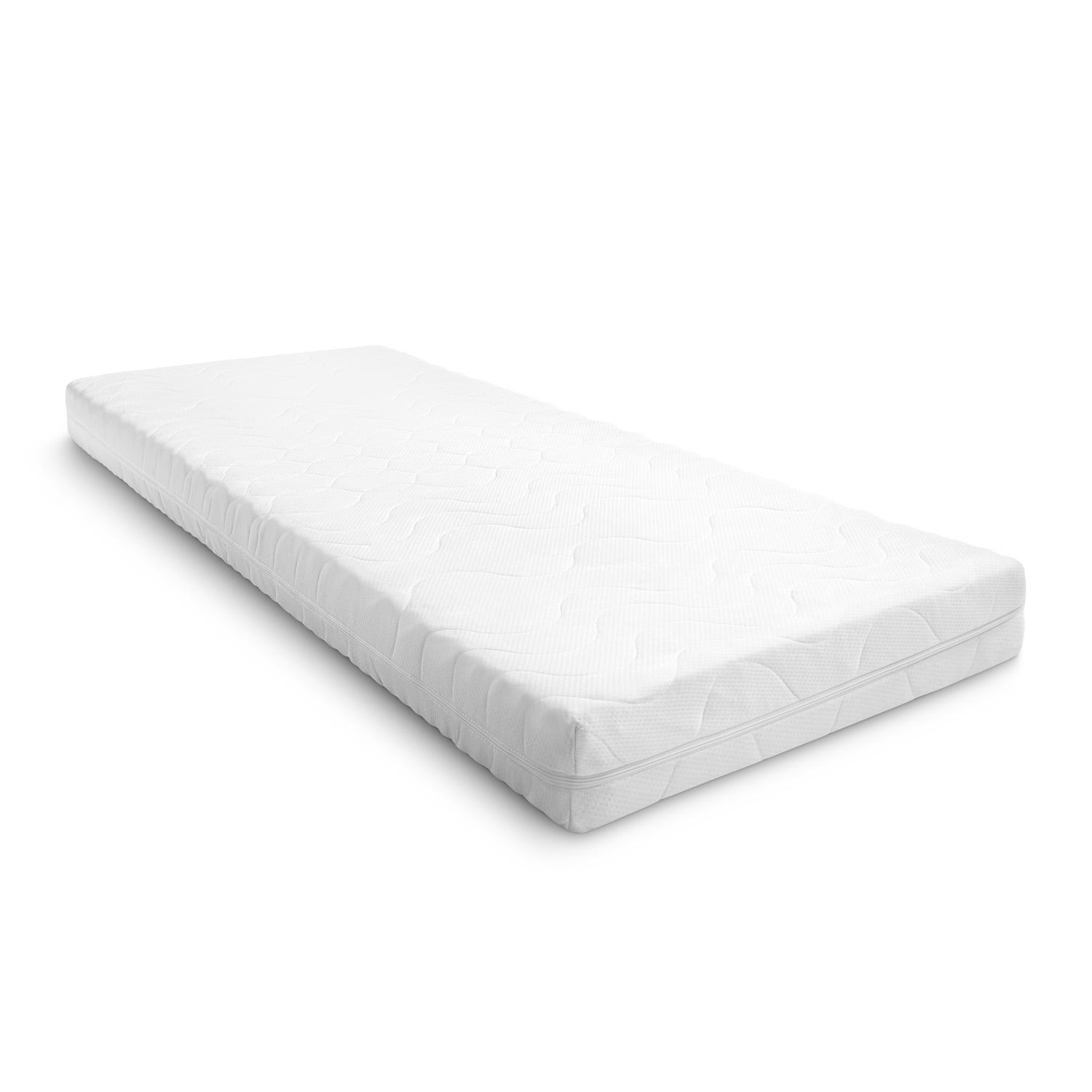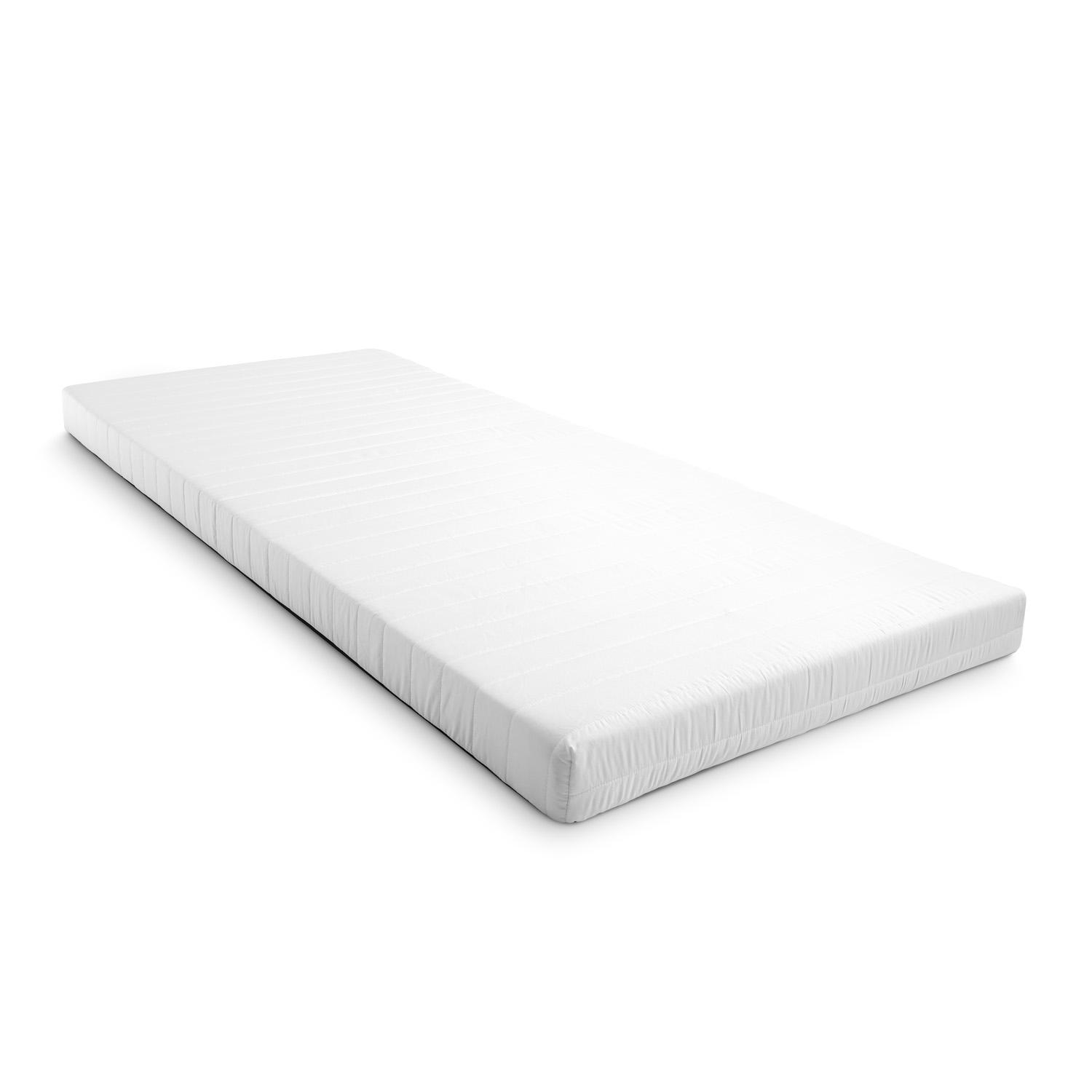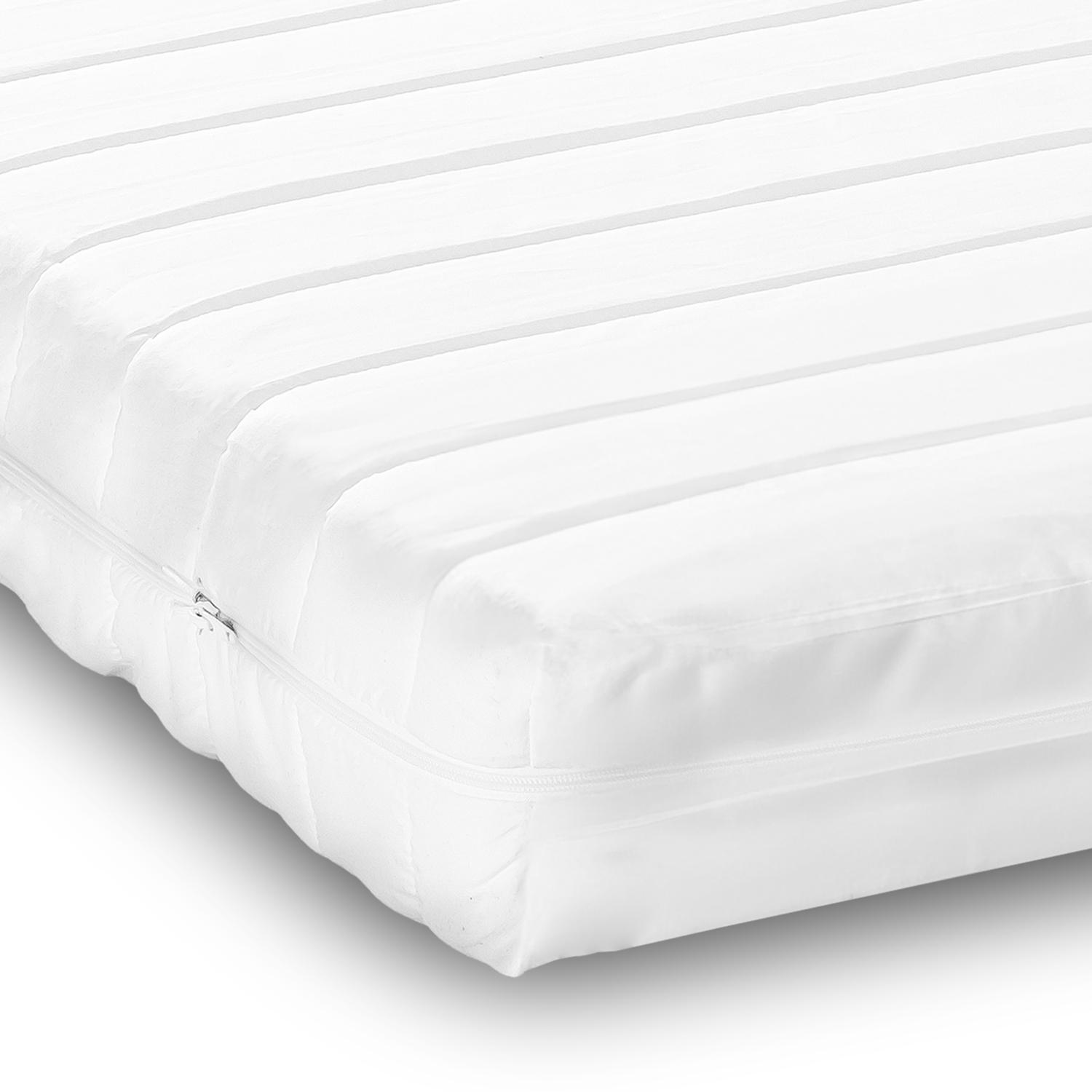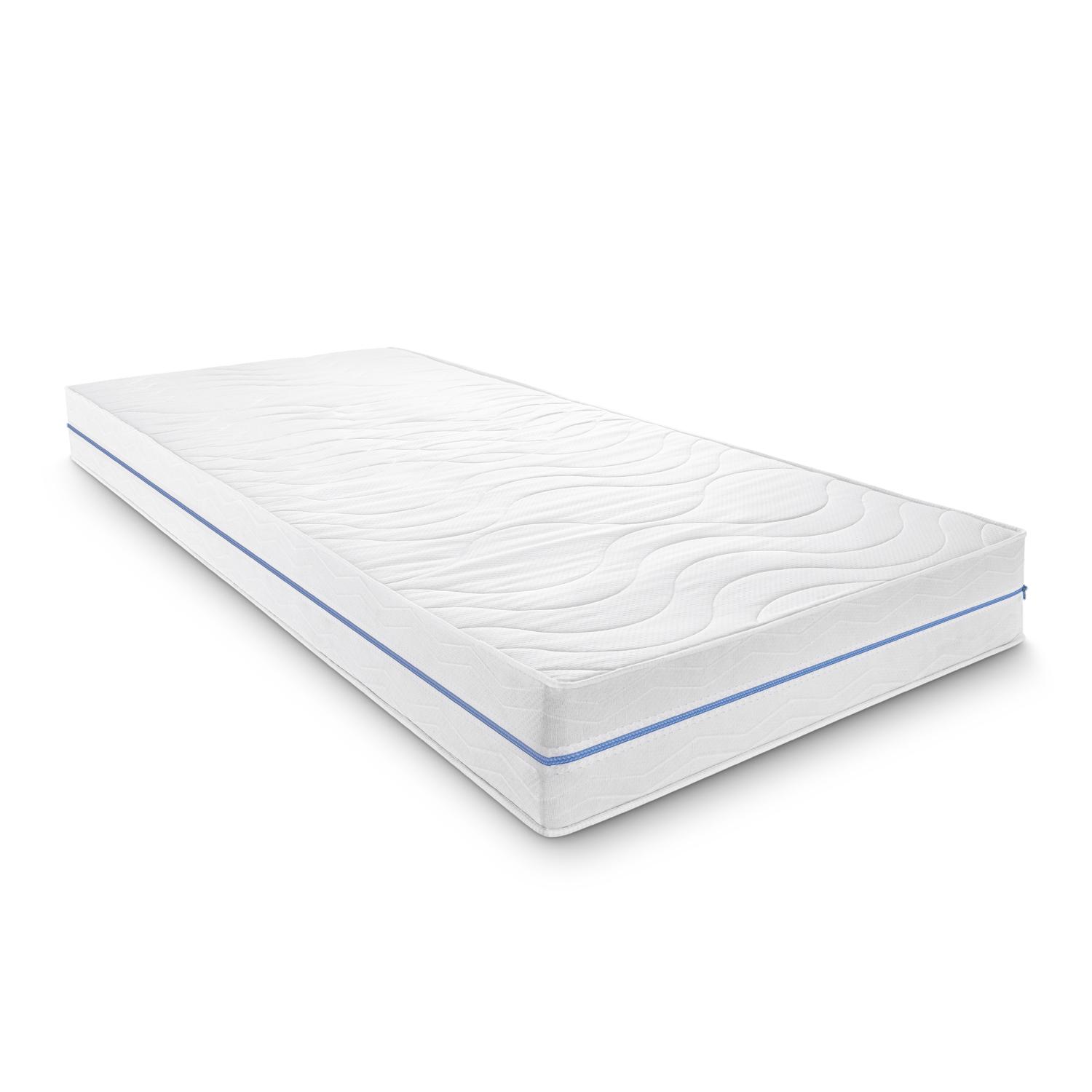How long does a mattress last?
30. December 2023
When is it time to replace the old mattress with a new one? We give you the facts and figures!
If you believe the Federal Statistical Office, married couples wear out around two mattresses in the course of their marriage. If it comes to it, three. Or to put it in figures: while the average marriage lasts 15 years and then ends in divorce, mattresses can only withstand the daily challenges in the bedroom for around five to eight years. Then, according to the experts at TÜV Rheinland, it's time to change the mattress.
TÜV Rheinland advises: Change the mattress after five to eight years
Nevertheless, changing mattresses tends to be neglected in many households. Yet there are good reasons, both in terms of hygiene and health, to replace the mattress just as regularly as clothes, the car or the television.
Why do mattresses age over the years?
A few figures on this too: On average, we spend eight hours a day in the bedroom. Of these, we spend around seven hours in the land of dreams. That's a projected 2,700 hours a year. No other piece of furniture in the home is used as intensively as the bed in the bedroom.
Sleepers spend 2,700 hours a year in bed
And yet "former youth and single beds" and their mattresses sometimes last for decades and are often passed down from generation to generation. With everything that has accumulated in the mattress over the years. And that's no small amount!
Fancy a few figures? Okay! We sweat while we sleep. And not a little. On average, we sweat out about half a liter to two liters of fluid every night. Most of the sweat is absorbed by the mattress. That's an annual average of several hundred liters of sweat. Per person, mind you.
A mattress absorbs several hundred liters of sweat per year per sleeper
Sweat itself is colorless. However, the salts, proteins and oils it contains leave unsightly sweat stains on the mattress. In addition, there is often a rancid to sour smell, as the sweat secreted contains fatty acids, which are broken down into two new components by the bacteria living on the skin: Butyric acid and formic acid. Sounds unpleasant? It is! Butyric acid is responsible for the rancid smell. The formic acid smells sour.
So, have you already pressed your nose into your mattress to check whether it's time for a change? Even if the smell test and the inspection of the mattress remain inconspicuous, this is no reason to give the all-clear for mattresses that are getting on in years. Because not everything that accumulates and multiplies in a mattress over the years is recognizable at first glance!
You've already guessed it, here are a few figures: Every sleeper loses around 1.5 grams of dander per night. That's more than 0.5 kg of dander that accumulates in the mattress over the course of a year. Twice as much in a double bed.
1 kg of dander accumulates per year as food for house dust mites in the marital bed
House dust mites, which cannot be seen at first glance as they are only 0.1 to 0.5 mm in size, love these skin flakes and feed on them. They also like it moist, warm and dark. Mattresses are therefore an ideal breeding ground for house dust mites. The mite itself is harmless. However, their excreted mite excrement can lead to numerous symptoms in people with a house dust allergy, similar to a cold. Itchy or watery eyes, headaches, coughing or a scratchy throat - such symptoms are often the result of a house dust mite allergy, which allergy sufferers experience every time they wake up.
Mite droppings are the second most common cause of allergies
Once the mattress has reached the end of its life after eight years, a total of around 2 million dust mites have found a comfortable home in the bed and left their allergenic mite droppings in the mattress.
When do I need a new mattress?
In addition to the recommendations of the testing institutes Stiftung Warentest and TÜV Rheinland to replace a mattress after around 8 years of use, there are obvious signs of ageing in mattresses that indicate the need for a change.
Worn mattresses - a common cause of poor lying and sleeping comfort
The main task of a mattress is to support the body and in particular the spine during sleep. Only if the spine is bedded in a straight and relaxed shape, without sagging or buckling, can the body recover during the night without tension or even pain. To achieve this, the mattress must have good point elasticity and ideally ensure optimum pressure distribution with different lying zones.
If the mattress is visibly or noticeably sagging in individual areas, this is an unmistakable sign that the support provided by the mattress has diminished. If dents, hollows or bulges are visible in the mattress, the inner foam in cold foam mattresses is often damaged or the filler has lost its elasticity. In spring core mattresses, the coil springs or the spring core pockets may be damaged, causing the metal springs to push through or leave unsupported craters in the mattress.
Going through thick and thin with your mattress? Not a good idea!
Ideally, a mattress with the right firmness level (H1 to H5) is adapted to your sleeping needs. If your weight changes significantly upwards or downwards, for example due to a change in diet or pregnancy, the firmness of the mattress is no longer optimal. An unsuitable firmness level can result in problems falling asleep, unpleasant pressure points on waking and even pain in the back and neck area. If you notice such signs after a weight fluctuation, it is advisable to change the mattress.
Does the mattress suit your sleeping position?
Just like the mattress, the sleeping position has a significant influence on healthy and, above all, relaxed sleep. The supine position is considered to be the best and most comfortable sleeping position. However, the majority of people sleep on their side, only a few people are stomach sleepers. A good mattress is tailored to the type of sleeper and offers optimum support for the respective sleeping position. It becomes problematic when the sleeping position changes. There can be various reasons for this and it is not unusual. It should then be ensured that the mattress also provides healthy sleep in the new sleeping position. If sleep becomes worse after changing sleeping position, replacing the mattress can help.
Orthopaedic mattresses are an important aid for illnesses
Pathological changes to the muscles or musculoskeletal system almost always require support for the body that is adapted to the respective illness, ideally with an orthopaedic mattress. Tension, back pain or pain in the cervical vertebrae and neck area should also not be taken lightly. If the problems and pain occur regularly, this is often due to an incorrect mattress.
Allergy-friendly mattresses alleviate allergy symptoms
The allergy symptoms of a house dust allergy are similar to those of a cold. Therefore, itchy eyes, headaches, a scratchy throat and similar cold symptoms often lead to the wrong conclusion. If these symptoms are often felt immediately after waking up and subside outside the bed, there is much to suggest that a new mattress with breathable climate fibers and a washable mattress cover can provide relief.
What should I bear in mind when buying a mattress?
When choosing a new mattress, two factors are usually decisive for the purchase. Firstly, the price of the mattress, which must fit into your own budget so that the household budget is not overstretched. Secondly, the feel and comfort of the mattress, as the sleeping experience should improve and not deteriorate with the purchase of a new mattress.
Comfort foam mattresses offer optimum value for money
Comfort foam mattresses, which are generally considered to be particularly durable and are also particularly inexpensive, offer an optimum combination of comfort, point elasticity, body contouring and an affordable purchase price. If you don't want to spend hundreds or even thousands of euros on a new mattress, a foam mattress with 7 ergonomic lying zones is an inexpensive alternative to spring or latex mattresses.
Allergy sufferers in particular should make sure that the mattress cover is removable and washable when buying a mattress. This makes it comparatively easy to alleviate allergy symptoms and the bed can be kept in a permanently hygienic condition.
Reversible mattresses with two different firmness levels offer the comfort of two mattresses for the price of one. Don't know which firmness level is best for you? Then choose a mattress with medium firmness levels H2 and H3. With these mattresses, one side is firmer and one side is softer. This allows you to find out at your leisure which firmness level suits you best.
When choosing a mattress, make sure that it has symmetrically arranged ergonomic reclining zones. Good foam mattresses have 7 lying zones to ensure optimum lying properties for all parts of the body,
The 7-zone lying comfort of foam mattresses
- Head and neck zone: This zone is slightly firmer to provide adequate support for the head and neck area, ensure correct alignment of the cervical spine and prevent tension.
- Shoulder zone: This zone is designed to be softer to allow the shoulders to sink slightly into the mattress. This reduces pressure on the shoulders, especially for side sleepers, and helps to keep the spine in a straight line.
- Lumbar zone: Here again, the mattress is slightly firmer to support the lumbar spine. This helps to support the natural curve of the lower back and prevent the back from sagging.
- Hip zone: This zone is often slightly firmer to support the weight of the hips and prevent them from sinking too far into the mattress, which could lead to spinal strain.
- Thigh zone: This zone has a medium firmness to support the thighs and contribute to an even weight distribution.
- Knee and calf zone: Similar to the thigh zone, the knee zone is designed with medium firmness to provide comfortable relief and support for the knees.
- Lower leg and foot zone: The last zone is again slightly firmer to provide adequate support for the lower legs and feet, promote blood circulation and relieve pressure on the joints.
Good to know: Zones 1, 2 and 3 as well as 5, 6 and 7 are symmetrical. The mattress can therefore be easily turned and rotated.
A good mattress accounts for around 70% of the sensation of lying down. The slatted frame is responsible for the remaining 30% and should ideally also be replaced regularly, as the wooden slats of slatted frames also age and lose their spring effect. When you replace the mattress, it is also worth taking a look at the slatted frame.
Where can I buy my new mattress?
At Matratzen Discount, you will find high-quality cold foam mattresses with 7 comfort zones in all standard mattress sizes and different material thicknesses. Equipped with two firmness levels (H2 and H3), the comfort mattresses offer the right firmness for every body weight.
CloudComfort - sleep like on clouds
Sleep like on clouds - that's what you can expect from the CloudComfort mattress, which boasts an ergonomic design and a removable, washable mattress cover.
Point-elastic cold foam mattress CloudComfort Premium mattress H2+H3 with good pressure relief and support .The optimized lying zones with memory-elastic properties ensure perfect adaptation to the body and increase lying comfort. The breathable cold foam ensures optimum air circulation, resulting in optimum heat regulation of the surface. Easy-care mattress cover made of microfiber, with zipper,…
incl. VAT
K10/K16 - price-performance winner for tight budgets
If you are looking for a particularly inexpensive new mattress to replace your old one, the K10 and K16 foam mattresses offer excellent sleeping bases with an outstanding price-performance ratio.
Point-elastic comfort foam mattressK10, firmness grade H3 with good pressure relief and support. The optimized lying zones with memory-elastic properties ensure perfect adaptation to the body and increase lying comfort. The breathable comfort foam ensures optimum air circulation, resulting in optimum heat regulation of the surface. Easy-care mattress cover made of microfiber, with zipper,…
incl. VAT
Point-elastic cold foam mattress made of breathable and point-elastic cold foam with 7 lying zones that ensure lying and sleeping comfort. Reversible firmness level H2+H3 (medium firm+firm). Easy-care mattress cover made of microfiber, with zipper, hard-wearing and durable, washable at 60 °C. Free from harmful substances, Oeko-Tex certified, in accordance with German quality standards,…
incl. VAT
Supportho - prevents back pain and tension
The orthopaedic Supportho mattress with 7 ergonomically shaped lying zones for optimum body adaptation with maximum pressure relief is recommended to relieve pain, for example back or neck pain, or to prevent tension.
Ergonomic Supportho Premiummattress with good pressure relief and support. Point-elastic lying zones provide precise support for the spine. Breathable and point-elastic cold foam, 7-zone cut, firmness grade H2+H3 (medium-firm+firm). Easy-care mattress cover made of microfiber, with zipper, hard-wearing and durable, washable at up to 60 °C. The mattress is ideal for use as a senior mattress as it…
incl. VAT




